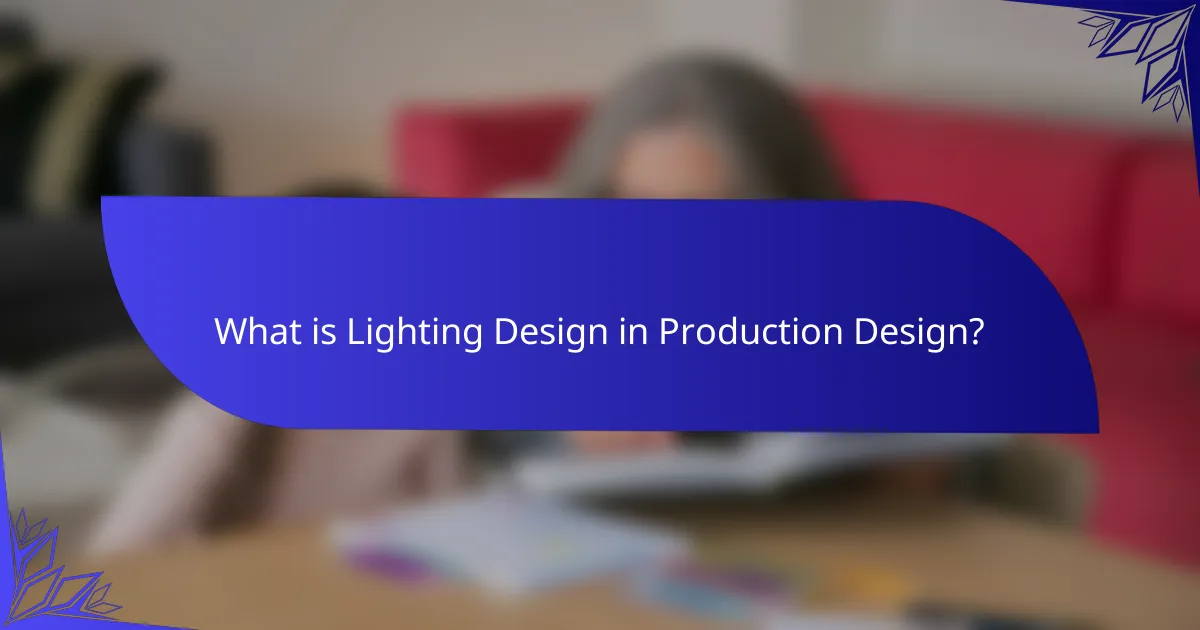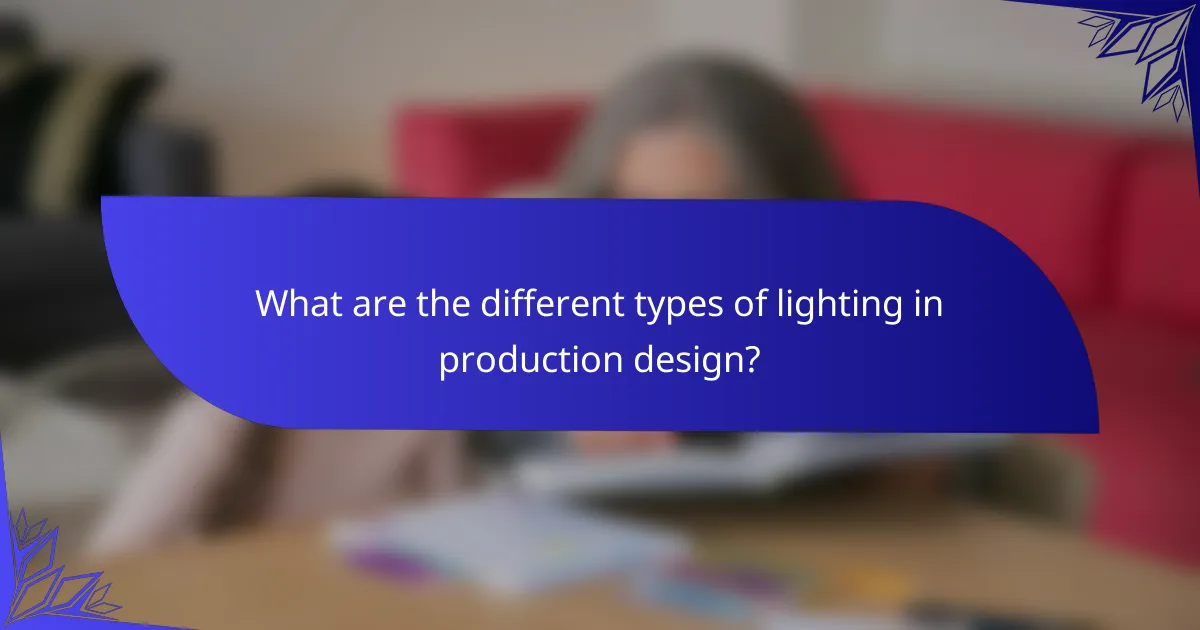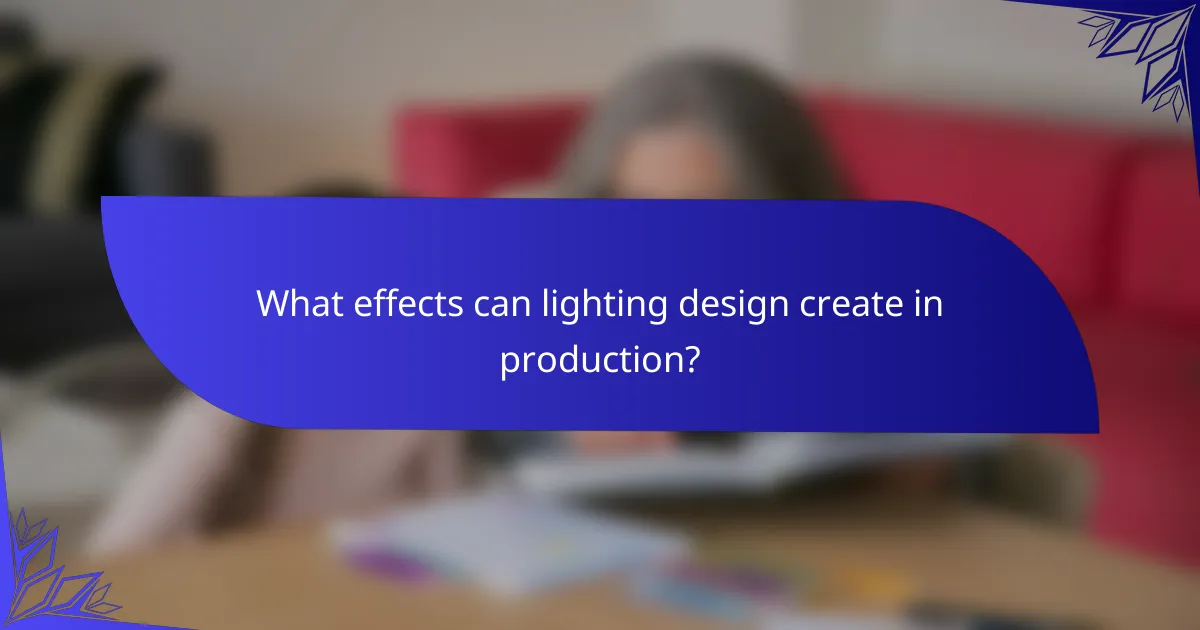Lighting design in production design is the strategic use of light to enhance visual storytelling across film, theater, and television. This discipline involves various types of lighting, including key lighting, fill lighting, backlighting, and ambient lighting, each contributing to the mood, atmosphere, and focus within a narrative. Effective lighting design influences audience perception and emotional response, shaping the overall experience of the production. The article explores the techniques and effects of lighting design, highlighting its importance in establishing time, place, and character, as well as its historical significance in visual narratives. Understanding these concepts is crucial for enhancing storytelling and audience engagement in production design.

What is Lighting Design in Production Design?
Lighting design in production design refers to the strategic use of light to enhance visual storytelling. It involves creating the mood, atmosphere, and focus within a production. This discipline considers various factors, including the intensity, color, and direction of light. Effective lighting design can influence audience perception and emotional response. It plays a crucial role in film, theater, and television. Historical examples include the chiaroscuro technique used in classic cinema. Lighting design is essential for establishing time, place, and character within a narrative.
How does Lighting Design influence the overall aesthetic of a production?
Lighting design significantly influences the overall aesthetic of a production. It sets the mood and tone, guiding audience perception. Effective lighting can enhance emotions and highlight key moments. Different colors and intensities create distinct atmospheres. For instance, warm lighting evokes comfort, while cool lighting may suggest tension. Additionally, shadows and contrasts add depth and dimension to scenes. Historical examples show that iconic productions utilize innovative lighting to achieve artistic goals. Therefore, lighting design is crucial in shaping the visual narrative of any performance.
What are the key elements that define Lighting Design?
The key elements that define lighting design include intensity, color, direction, and distribution. Intensity refers to the brightness of the light used in a space. It affects mood and visibility. Color influences the atmosphere and emotional response. Direction determines how shadows and highlights shape the environment. Distribution relates to how light is spread across a surface. Each element plays a crucial role in creating the desired effect in production design. Understanding these elements allows designers to manipulate light effectively for storytelling.
How does the choice of lighting affect mood and atmosphere?
The choice of lighting significantly affects mood and atmosphere. Different lighting types create distinct emotional responses. For example, warm lighting often evokes feelings of comfort and intimacy. In contrast, cool lighting can induce a sense of calm or detachment. Bright lighting tends to energize a space, while dim lighting often fosters relaxation or romance. Studies show that color temperature impacts perception; warmer lights (around 2700K) are associated with coziness, while cooler lights (above 5000K) promote alertness. Additionally, the placement of light sources influences shadows and highlights, altering spatial perceptions and emotional reactions. Thus, effective lighting design is crucial in shaping the intended mood and atmosphere in a space.
Why is Lighting Design important in storytelling?
Lighting design is crucial in storytelling as it shapes the audience’s emotional experience. It sets the mood and tone of a scene, influencing how viewers perceive characters and events. For instance, bright lighting can evoke feelings of happiness or clarity, while dim lighting can create suspense or tension. Studies show that lighting can significantly affect audience engagement and comprehension. According to a study published in the Journal of Media Psychology, effective lighting enhances narrative immersion. This demonstrates that lighting design is not just an aesthetic choice but a fundamental element of storytelling.
How does lighting guide audience perception and focus?
Lighting influences audience perception and focus by directing attention and creating mood. It highlights specific areas, guiding viewers to important elements. Bright lighting typically draws focus, while dim lighting can evoke feelings of intimacy or suspense. Different colors in lighting can also alter emotional responses. For instance, warm colors may create comfort, while cool colors can induce calmness. Research shows that lighting affects cognitive processing and emotional reactions. A study by Küller et al. (2006) found that well-designed lighting can enhance engagement and comprehension in audiences. Thus, effective lighting design is crucial in production to shape viewer experience.
What role does lighting play in character development?
Lighting plays a crucial role in character development by influencing audience perception and emotional response. It shapes how characters are viewed, revealing their traits and motivations. For instance, harsh lighting can create a sense of discomfort or villainy, while soft lighting may evoke warmth and innocence. Different lighting techniques, such as chiaroscuro, can highlight internal conflicts within a character. The use of color temperature also affects mood; warm tones suggest comfort, while cool tones imply tension. Historical examples include film noir, where low-key lighting emphasizes moral ambiguity. Overall, lighting is a powerful tool that enhances storytelling by deepening character complexity.

What are the different types of lighting in production design?
The different types of lighting in production design include key lighting, fill lighting, backlighting, and ambient lighting. Key lighting serves as the primary source of illumination, highlighting the main subject. Fill lighting softens shadows created by key lighting, providing a more balanced look. Backlighting creates depth by illuminating the subject from behind, often producing a silhouette effect. Ambient lighting offers general illumination, filling the space with soft light. Each type contributes to the overall mood and visual storytelling in production design. Understanding these lighting types enhances the effectiveness of visual narratives.
What are the main categories of lighting used in productions?
The main categories of lighting used in productions are key light, fill light, backlight, and practical light. Key light is the primary source of illumination, defining the subject’s features. Fill light reduces shadows created by the key light, providing balance. Backlight creates separation between the subject and background, enhancing depth. Practical light refers to light sources visible within the scene, adding realism. Each category serves a distinct purpose in achieving desired visual effects.
How do ambient, task, and accent lighting differ?
Ambient lighting provides overall illumination in a space. It creates a uniform light level, ensuring visibility and comfort. Task lighting focuses on specific areas to aid activities like reading or cooking. It is brighter and more directed than ambient lighting. Accent lighting highlights particular features or objects, such as artwork or architectural details. It adds drama and visual interest to a space. Each type of lighting serves a distinct purpose in design, enhancing functionality and aesthetics.
What are the characteristics of natural versus artificial lighting?
Natural lighting is sunlight that illuminates spaces without artificial sources. It varies in intensity and color temperature throughout the day. Natural light creates a dynamic atmosphere that changes with weather conditions. It often enhances colors and textures in a space.
Artificial lighting is produced by electric sources like bulbs and LEDs. It provides consistent illumination regardless of external conditions. Artificial light can be adjusted for brightness and color temperature. It allows for control over the mood and functionality of a space.
Natural lighting is generally softer and more diffuse. Artificial lighting can be harsh and create shadows if not designed properly. Both types of lighting serve unique purposes in design and can be combined for optimal effects.
How do various lighting techniques impact production design?
Various lighting techniques significantly impact production design by influencing mood, focus, and visual storytelling. For instance, high-key lighting creates an upbeat atmosphere, often used in comedies. In contrast, low-key lighting generates tension and drama, common in thrillers.
The use of colored lighting can evoke specific emotions or highlight themes. For example, blue lighting often conveys sadness, while warm tones suggest comfort. Additionally, directional lighting enhances textures and shapes, adding depth to sets and characters.
Lighting also directs audience attention to key elements in a scene. Spotlighting can isolate a character or object, guiding viewer focus. Conversely, ambient lighting creates a natural feel, integrating the environment into the narrative.
Overall, the choice and application of lighting techniques are crucial in shaping the visual identity and emotional resonance of a production design.
What techniques are commonly used to create dramatic effects?
Common techniques used to create dramatic effects include high contrast lighting, color filters, and shadows. High contrast lighting enhances the visual impact by emphasizing light and dark areas. This technique can create tension and highlight important elements in a scene. Color filters alter the mood and atmosphere by changing the hue of the light. Different colors evoke various emotions, influencing audience perception. Shadows add depth and dimension, creating a sense of mystery or foreboding. The strategic placement of light sources can manipulate shadows for dramatic effect. These methods are widely used in theater and film to enhance storytelling and engage viewers.
How does color temperature influence the perception of a scene?
Color temperature significantly influences the perception of a scene. It affects the mood and emotional response of viewers. Warmer color temperatures, like those around 2700K to 3000K, create a cozy and inviting atmosphere. Cooler temperatures, such as 5000K to 6500K, evoke a sense of clarity and professionalism.
Studies indicate that color temperature can alter a viewer’s interpretation of a scene. For example, the research by K. A. McCulloh et al. in “The Influence of Color Temperature on Mood” shows that warmer lighting enhances feelings of comfort. Conversely, cooler lighting can promote alertness and focus.
These effects are utilized in various fields, including film and interior design, to convey specific narratives or emotions. Thus, color temperature is a critical element in shaping how scenes are perceived.

What effects can lighting design create in production?
Lighting design can create various effects in production, including mood enhancement, focus direction, and spatial perception. Effective lighting influences the audience’s emotional response. For example, warm lighting can evoke feelings of comfort, while cool lighting may create tension. Additionally, lighting can highlight specific actions or characters, guiding viewer attention. It also shapes the perception of space, making areas appear larger or smaller. Historical productions have utilized lighting to signify time changes or transitions. The right lighting design can transform a scene completely, impacting storytelling and audience engagement.
How does lighting affect viewer emotions and reactions?
Lighting significantly influences viewer emotions and reactions. Different lighting conditions can evoke specific feelings. For example, warm lighting often creates a cozy and inviting atmosphere. In contrast, harsh, cool lighting may induce feelings of tension or discomfort. Studies show that dim lighting can enhance romantic feelings, while bright lighting can increase alertness and focus. The color temperature of light also plays a crucial role; blue light is associated with calmness, whereas red light can trigger excitement or urgency. Additionally, lighting can affect how viewers perceive space and depth, impacting their overall experience. These emotional responses are utilized in various fields, including film, theater, and interior design, to enhance storytelling and engagement.
What psychological impacts does lighting have on an audience?
Lighting significantly influences the psychological state of an audience. It can evoke emotions, set moods, and affect perceptions. Bright lighting often generates feelings of happiness and energy. Conversely, dim lighting can create a sense of intimacy or sadness. Color temperature also plays a role; warm light can be comforting, while cool light may feel sterile. Research indicates that different lighting styles can enhance focus and attention. For instance, studies show that well-lit environments improve cognitive performance and mood. Additionally, lighting design can guide audience attention and create dramatic tension in a narrative. Overall, lighting is a vital tool in shaping audience experience and emotional response.
How can lighting be used to evoke specific themes?
Lighting can be used to evoke specific themes by manipulating intensity, color, and direction. Different colors can create distinct emotional responses. For example, warm colors like red and orange can convey passion or danger. In contrast, cool colors like blue and green often evoke calmness or sadness.
The intensity of lighting also plays a crucial role. Bright lighting can create a sense of happiness or excitement, while dim lighting can evoke mystery or tension. Directional lighting can highlight specific elements, guiding the audience’s focus and enhancing thematic elements.
For instance, low-angle lighting can create dramatic shadows, suggesting danger or unease. High-angle lighting often produces a more open and inviting atmosphere. Historical examples include film noir, which uses stark contrasts and shadows to evoke themes of suspense and moral ambiguity.
Thus, the strategic use of lighting is essential in production design to effectively communicate themes and emotions to the audience.
What are the challenges faced in lighting design?
Lighting design faces several challenges. One major challenge is achieving the right balance between functionality and aesthetics. Designers must ensure that lighting meets practical needs while also enhancing the visual appeal of a space. Another challenge is managing energy efficiency. With rising energy costs and environmental concerns, designers need to select sustainable lighting solutions.
Additionally, controlling light quality is crucial. Designers must consider color temperature and intensity to create the desired atmosphere. Another challenge is the integration of technology. Advances in smart lighting require designers to stay updated on new tools and systems.
Finally, addressing user needs is essential. Designers must understand how different users interact with light in various environments. These challenges require a combination of creativity, technical knowledge, and adaptability in lighting design.
How can technical limitations affect lighting choices?
Technical limitations can significantly impact lighting choices in production design. These limitations include equipment constraints, power availability, and environmental conditions. For example, insufficient power supply can restrict the number of lights used. This limitation may lead to reduced brightness or fewer lighting effects. Additionally, certain environments may not support heavy lighting setups. This can necessitate the use of lighter, more portable lighting solutions. Furthermore, available technology may limit the types of lighting effects achievable. For instance, older lighting fixtures may not support advanced features like color mixing or dimming. Therefore, technical limitations often dictate the feasible lighting design options in a production setting.
What are common mistakes to avoid in lighting design?
Common mistakes to avoid in lighting design include inadequate planning and failing to consider the space’s purpose. Poor lighting can lead to discomfort and reduced functionality. Another mistake is not using a layered approach, which combines ambient, task, and accent lighting. Ignoring the color temperature of lights can also affect the mood and ambiance. Overly bright or harsh lighting can create glare and fatigue. Additionally, neglecting maintenance of lighting fixtures can lead to inconsistent performance. Finally, not taking into account natural light sources can result in poorly balanced lighting throughout the day.
What best practices should be followed in lighting design?
Effective lighting design should prioritize functionality, aesthetics, and energy efficiency. First, assess the purpose of the space to determine appropriate lighting types. Use a combination of ambient, task, and accent lighting for balanced illumination. Select fixtures that complement the overall design and enhance the space’s character. Consider the color temperature of bulbs; warmer tones create a cozy atmosphere, while cooler tones promote alertness. Implement dimmers to adjust light levels according to different activities and times of day. Ensure proper placement of lights to minimize shadows and glare. Utilize energy-efficient lighting options, such as LED bulbs, to reduce consumption and costs. Regular maintenance is essential to ensure longevity and performance of lighting fixtures.
How can one effectively plan and execute a lighting design concept?
To effectively plan and execute a lighting design concept, one must start with a clear vision of the desired atmosphere. This involves understanding the purpose of the space and the emotions to evoke. Next, create a detailed lighting plan that includes the types of fixtures, their placement, and control systems. Consider the layering of light, which includes ambient, task, and accent lighting.
Using software tools can help visualize the design before implementation. Select appropriate color temperatures and intensities to enhance the desired effects. Collaborate with other design team members to ensure cohesive integration with other elements.
Finally, conduct thorough testing and adjustments during the installation phase to achieve the intended outcome. Research indicates that effective lighting design can significantly impact audience perception and engagement in production settings.
What tools and technologies are essential for modern lighting design?
Essential tools and technologies for modern lighting design include software, fixtures, and control systems. Design software like AutoCAD and Revit aids in creating detailed lighting plans. 3D modeling tools such as SketchUp allow for visualizing lighting effects in spaces. LED fixtures offer energy efficiency and versatility in color and intensity. Smart lighting control systems enable remote operation and automation. Dimming systems provide flexibility in light levels. Light meters measure illumination, ensuring designs meet required standards. These tools collectively enhance the precision and creativity of lighting design.
Lighting design is a critical aspect of production design that strategically utilizes light to enhance visual storytelling across film, theater, and television. This article explores the various types of lighting, including key, fill, back, and ambient lighting, and discusses their impact on mood, atmosphere, and character development. Key elements such as intensity, color temperature, and direction are examined to illustrate how they influence audience perception and emotional response. Additionally, the article addresses common challenges in lighting design and best practices for effective implementation, highlighting the importance of lighting in shaping narratives and viewer engagement.